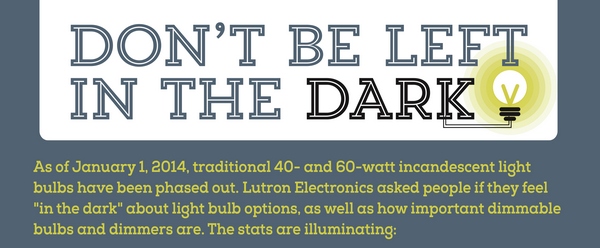Under a little-known requirement that went into effect this week, the last of the “general service” incandescent bulbs—descendants of the original light bulb invented by Thomas Alva Edison in 1879— can no longer be manufactured or imported into the U.S.
This requirement marks the final stage of the Bush-era Energy Independence and Security Act legislation (EISA) of 2007, spelling the end of the 40 and 60 watt standard incandescent bulb. The 100 and 75 watt bulbs were phased out previously, in 2012 and 2013.
To explore some of the ramifications of the phase-out—outlined in a new survey released last month—a panel of experts gathered in New York City just before the law went into effect. Their purpose was to discuss the dimensions of the problem as well as options available.
According to the survey, which was conducted for Lutron Electronics—the company that organized the New York panel—very few Americans are even aware of the phase-out. The Lutron survey, which polled 1,000 adults in the U.S. in November 2013, revealed that fewer than one in three understood that the familiar 40 and 60 watt bulbs were soon to disappear.
 |
 |
 |
|
An infograph of Lutron's survey of 1,026 New Yorkers aged 18 and older awareness of the incandescent light ban. Survey conducted between Nov. 25-27, 2013. (LEDinside/ Lutron) |
“But since the 40 and 60 watt incandescent bulbs represent more than 60 percent of all U.S. household bulbs sold annually, some people will definitely be in for a shock.”“Manufacturers, retailers and others in the lighting industry—including the trade and general press—have been working to get the word out for the past two years,” said Terry McGowan, director of engineering for the American Lighting Association and a member of the panel.
The Lutron survey, conducted by The Futures Company, an independent research organization, also found that only one in 10 adults is familiar with other options, including Light Emitting Diode (LED) lamps and Compact Fluorescents Lamps (CFLs). This corroborates a recent report by the National Electrical Manufacturers Association to the effect that CFL market penetration remains flat and LEDs are being used in only about one percent of all U.S. sockets.
Another member of the panel, Jason Byron Teague, a New York City-based lighting designer, said his clients have very low awareness of the post phase-out options. “I hear the same things from all my clients—‘halogen bulbs are higher priced, the curly bulbs (CFLs) don’t look good’ and ‘LEDs are unfamiliar as well as new and expensive’— so it’s clear people don’t have enough information to make a decision. I tell them there’s room for all of these new bulbs in a home and that the placement of them is really dependent on lifestyle,” said Teague.
While most people seem to be in the dark about their options, three-quarters of those surveyed said it’s important that the new energy-efficient bulbs be dimmable.
For Ethan Biery, Lutron’s LED lighting expert, that’s a mandate for manufacturers to come up with better compatibility between the lamps and the dimmers.
“All halogen bulbs are dimmable, as are most LEDs—provided that the package indicates as much—but the majority of CFL and LED bulbs will not perform the same way as an incandescent when actually dimmed,” he explained. “Consumers may experience buzzing of the lamp or dimmer, flickering lights, long start times, non-smooth dimming or lights dropping out or popping on when the dimmer is operated.”
To eliminate some of these problems and accelerate the transition to more energy-efficient bulbs and lighting systems, Lutron is working with dozens of lamp manufacturers to improve dimmer compatibility.
“People have been dimming their lights electronically since the early 1960s, when Lutron—the company that invented the household dimmer—introduced the idea.
But the original dimmers were designed for incandescent bulbs, not the LEDs and CFLs of today,” said Biery, who pointed out that the company recently introduced a line of dimmers that works with dimmable LEDs and CFLs as well as halogen and incandescent bulbs.
Another member of the panel, Stan Mertz, director of operations for Applied Proactive Technologies, a firm that designs and implements residential incentive programs, credited utility companies for providing incentives to reduce the cost of purchasing energy efficient products such as CFLs, LEDs, dimmers and occupancy sensors.
“At the moment, less than half the households in America have converted to energy-efficient bulbs. Homeowners would be more inclined to make the switch if they were presented with an incentive that reduces the cost for these types of bulbs,” said Mertz.
While no one knows for sure which option consumers will embrace in 2014—LEDs, CFLs or halogens–one thing is for sure. Consumers may be in the dark about their options, but they are nearly unanimous in hoping that the light at the end of the tunnel will be dimmable.














